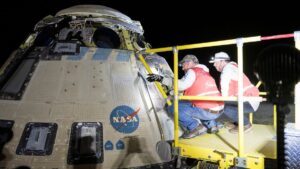BP’s technology could one day be used to continue drilling Mars or the moon after it entered into an agreement with the American space agency Nasa.
Under the terms of the agreement, the two agreed to share their technology and expertise gained from working “in hostile environments”.
BP believes the deal will help advance its plans to drill for oil and gas on Earth, while helping advance human exploration of the moon, Mars and other planets in the solar system.
“Both BP and Nasa are custodians of deep technical expertise, working in extreme environments – whether at the bottom of the sea or on the moon,” said Giovanni Cristopoli, a senior manager at BP.
“Sharing what we know will help us solve complex engineering problems faster, meaning we can focus on keeping energy flowing safely and delivering higher margins with lower emissions,” added Cristopoli.
This can include sharing digital models and simulations that allow engineers and scientists to test new equipment, whether 14,000 feet underwater or 140m miles (225m km) away on another planet.
In time, it could also lay the foundation for future cooperation on the use of hydrogen, regenerative fuel cells, high-capacity batteries, solar power systems, small-scale nuclear power systems.
The latest tie-up between big business and space explorers has emerged just over a year after the UK space agency agreed to back research by Rolls-Royce about how its small-scale nuclear power technology could be used to provide the electricity needed for humans to live and work on the moon.
George Freeman, MP, and the former science minister, said at the time: “Space exploration is the ultimate laboratory for so many of the transformational technologies we need on Earth: from materials to robotics, nutrition, cleantech and much more.”
to newsletter promotion
BP’s experience in deep-sea drilling could be useful in exploring Mars, where scientists recently discovered potentially large amounts of water trapped deep within its crustwhich raises new questions about the possibility of life on the red planet.
New calculations by scientists have found that “ancient Martian oceans” may be trapped in rocks about seven to 12 miles below the planet’s surface, which could prove to be a “key ingredient” for the possibility of life on Mars.



